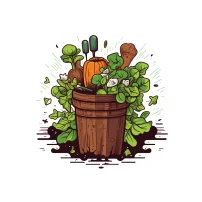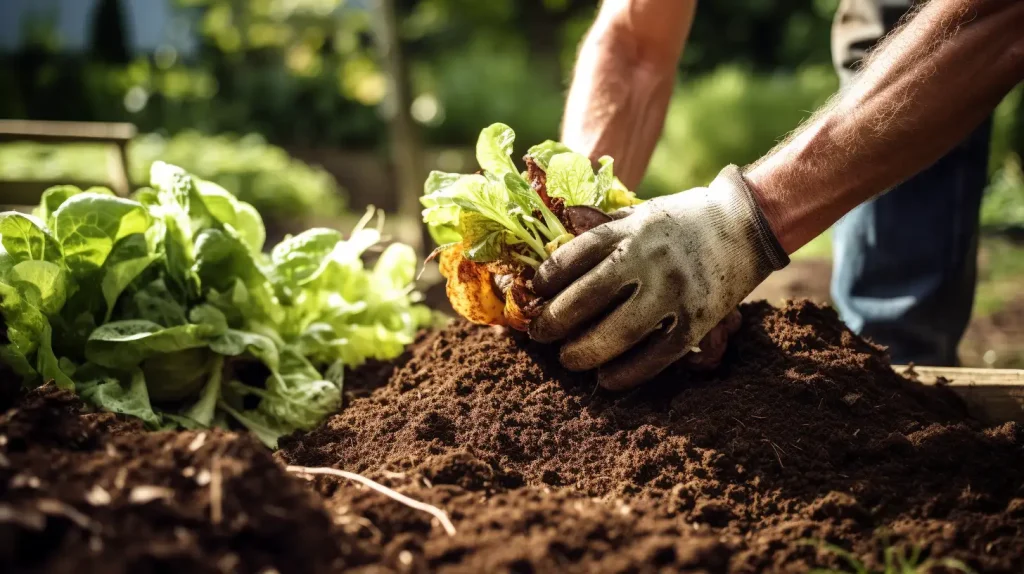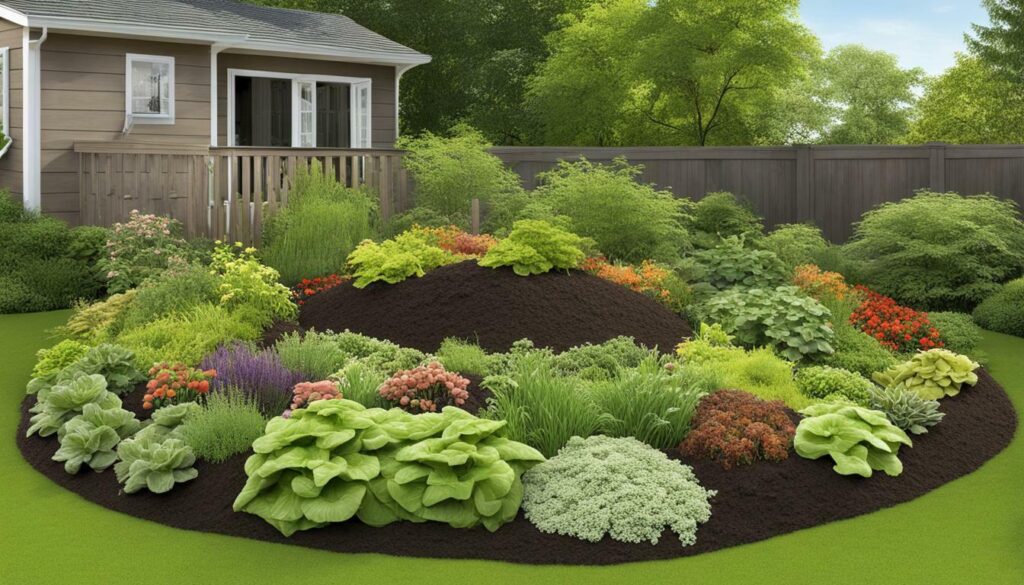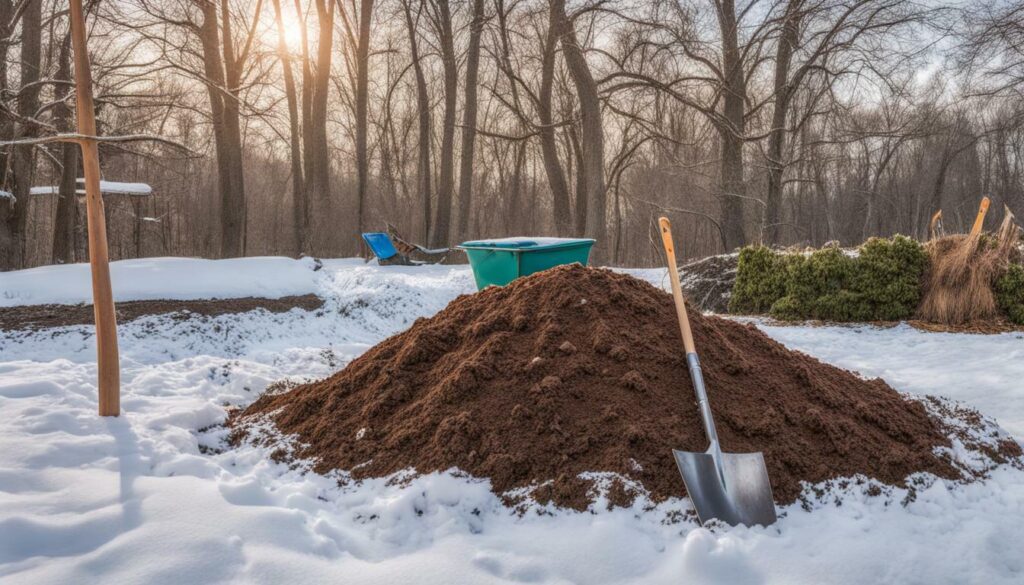Compost is an essential element in any organic gardener’s toolkit. It’s a rich soil amendment that can improve soil structure, increase nutrient content, and promote beneficial microbial activity, leading to healthier and more productive plants. In this article, we’ll provide tips and tricks for using compost effectively in your garden, from incorporating it into soil preparation to using it as mulch or liquid fertilizer.
Key Takeaways:
- Compost is a valuable soil amendment that can improve soil health and plant growth.
- There are different methods for incorporating compost into soil preparation, including top-dressing, trenching, and mixing.
- Compost can be used as a natural fertilizer and mulch to help suppress weeds, regulate soil temperature, conserve moisture, and enhance overall soil health.
- Composting techniques such as traditional composting, vermicomposting, and compost tea brewing can provide high-quality compost for your garden.
- By troubleshooting common composting issues, maximizing compost effectiveness, and ensuring quality compost, you can reap the benefits of this valuable resource in your garden.
Understanding the Benefits of Using Compost in Gardening
Compost is a nutrient-rich soil amendment that offers numerous benefits to gardening enthusiasts.
One of the primary benefits of using compost in gardening is that it improves soil structure and fertility. Compost contains a balanced combination of macronutrients, micronutrients, and organic matter that can enhance the growth and productivity of plants.
In addition to its nutrient content, compost can also promote beneficial microbial activity in the soil. These microorganisms help break down organic matter and convert it into plant-available nutrients that are essential for healthy plant growth.
Compost can also increase water retention in the soil, ensuring that plants have a consistent source of moisture even during dry spells. The ability of compost to regulate soil temperature can be beneficial in harsh weather conditions.
When gardeners use compost as a fertilizer and soil amendment, it eliminates the need for synthetic fertilizers and chemical pesticides. This reduces the cost of gardening and is more environmentally friendly.
By enriching soil with compost, gardeners can enjoy healthier and more productive plants, a more diverse range of beneficial insects, and better soil health over time.
Incorporating Compost into Soil Preparation
One of the most common methods of using compost in gardening is to incorporate it into soil preparation. This process involves mixing the compost with the soil to improve its overall quality. There are several compost application methods gardeners can use, each with its own benefits and drawbacks:
| Method | Description |
|---|---|
| Top-dressing | Spread a thin layer of compost on top of the soil and let it mix in naturally over time. This is a low-maintenance method that can help suppress weeds and retain moisture. |
| Trenching | Dig a trench in the soil and fill it with compost before covering it back up. This method is particularly helpful for plants with deep root systems, as it allows the compost to reach the roots directly. |
| Mixing | Mix the compost with the soil using a tiller or garden fork. This method ensures that the compost is evenly distributed throughout the soil, but may require more labor and equipment. |
Regardless of the method used, it’s important to evenly distribute the compost throughout the garden bed. Gardeners can also use compost as a natural fertilizer, providing essential nutrients to their plants. To do this, it’s recommended to mix the compost with the soil prior to planting. In general, gardeners should aim to use a 1:1 ratio of compost to soil.
Using compost in soil preparation is an effective way to improve overall soil health and promote healthy plant growth. Gardeners can experiment with different methods to find the one that works best for their garden’s unique needs.
Compost for Vegetable Gardens
Using compost in vegetable gardens can provide numerous benefits for plants and soil health. Compost is an excellent source of organic matter, which can improve soil structure, increase water-holding capacity, and promote beneficial microbial activity. Additionally, compost can provide essential nutrients that support healthy growth and increase the flavor and nutritional value of vegetables.
When using compost in vegetable gardens, it is important to apply it evenly throughout the garden bed. Gardeners can mix compost into the top few inches of soil before planting, use it as a side dressing around established plants, or apply it as a thin layer on top of the soil as mulch. A general guideline is to apply one to two inches of compost per season, depending on the needs of the plants.
Organic gardening with compost in vegetable gardens can reduce the need for synthetic fertilizers, which can harm soil health and the environment. Compost can also improve soil drainage, which can prevent waterlogged conditions that can lead to root rot and other plant diseases.
When using compost for vegetable gardens, it is important to ensure that it has fully decomposed. Immature or unfinished compost can contain pathogens or phytotoxic compounds that can harm plants. Gardeners can assess the maturity of their compost by checking for signs of decomposition, such as a crumbly texture, earthy smell, and absence of recognizable organic materials.
By including compost in their vegetable gardens, gardeners can promote healthy plant growth and improve the overall health of their soil.
Composting Techniques for Gardeners
Composting is a simple yet effective way to create nutrient-rich soil for your garden. As a beginner, getting started with composting can be a little intimidating. However, with the right techniques and tips, anyone can successfully compost in their backyard. In this section, we will cover some composting techniques that are suitable for gardeners of all levels.
Traditional Composting
One of the easiest ways to compost is through traditional composting. This method involves creating a pile of organic material and letting it decompose over time. To get started, select a location in your backyard that receives partial sunlight and has good drainage. Begin by layering your green and brown materials, making sure to alternate between them. Add water to the pile to maintain a moistened but not saturated environment. Turn the pile regularly to ensure proper aeration and mix the materials for quicker decomposition. After a few weeks, you should notice steam rising from the pile, indicating that the compost is working. Once the pile has broken down and has a soil-like texture, it is ready to be added to your garden.
Vermicomposting
Vermicomposting is another popular composting technique that uses worms to break down organic material quickly. These worms work to aerate and mix the composting materials, accelerating the decomposition process. To start vermicomposting, you will need a worm bin and redworms. Place shredded newspaper at the bottom of the bin and add food scraps on top. Keep the bin in a cool, dark location to avoid exposing the worms to direct sunlight. Ensure that the bedding remains moist, and add more food scraps as needed. In a few months, you will have rich, nutrient-dense compost to use in your garden.
Compost Tea Brewing
Compost tea is a liquid fertilizer made by steeping compost in water. This technique allows nutrients to be easily absorbed by plants, making it a great alternative to traditional fertilizers. To make compost tea, fill a bucket with water and place a mesh bag filled with compost in the bucket. Let the bag steep for several hours, stirring occasionally. Remove the bag and dilute the tea with water before applying it to your garden. This technique is especially useful for container gardens or for plants that need a quick nutrient boost.
Common Challenges and Troubleshooting
Composting can sometimes be challenging, especially for beginners. Common issues include foul odors, slow decomposition, and pest infestations. To avoid these problems, make sure to balance your green and brown materials, maintain proper moisture levels, and turn the compost pile regularly. If you notice a foul smell, add more brown materials to the pile. If pests are an issue, make sure to bury the food scraps deeper in the pile.
With these tips and techniques, composting can be an easy and rewarding process. Start small and experiment with different methods to find the one that works best for your garden. Whether you choose traditional composting, vermiculture, or compost tea brewing, your plants will thank you for the nutrient-rich soil that compost provides.
Using Compost as Mulch
Aside from incorporating compost into the soil, gardeners can also use compost as a natural mulch to improve soil health and enhance plant growth. Compost mulch can help regulate soil temperature, conserve moisture, and suppress weed growth.
Applying compost as mulch is easy. Simply spread a layer of compost around the base of plants, making sure to leave space around the stems to prevent rot. Aim for a thickness of 2-3 inches for maximum effectiveness. It’s best to apply compost mulch in the spring or fall when the soil is moist, but avoid adding it during the hottest part of summer as it can dry out the soil and damage plant roots.
Using compost as mulch has numerous long-term benefits for plants. As the compost breaks down, it releases nutrients into the soil, providing a slow-release fertilizer for the plants. The organic matter in the compost also encourages beneficial microbial activity in the soil, improving soil structure and promoting healthier root growth.
Organic gardening with compost as mulch is especially beneficial for vegetables and other edible plants. Not only does the compost provide essential nutrients for healthy growth, but it can also improve the flavor and nutritional value of the harvested produce.
Compost Tea: An Effective Liquid Fertilizer
Gardeners looking for an all-natural, nutrient-packed fertilizer should consider compost tea. Compost tea is made by steeping compost in water to create a liquid fertilizer that can be sprayed onto plants or applied to the soil directly.
Compost tea is a great way to deliver a concentrated dose of nutrients to plants and improve soil health. The liquid form allows the nutrients to be easily absorbed by plant roots, and the beneficial microbes in the compost tea can help improve soil structure and promote a healthy microbe population in the soil.
Here are some steps for making compost tea:
- Place a mesh bag or cheesecloth filled with compost in a bucket or container of water.
- Let the compost steep for 24-48 hours.
- Remove the compost bag and dilute the compost tea with water (a 1:10 ratio is recommended).
- Apply the compost tea to plants or soil.
Compost tea can be applied to the soil directly or sprayed onto plants. It’s important to use a sprayer with a fine mist to prevent clogging and to ensure an even application.
When making compost tea, it’s important to use quality compost that has been fully decomposed. Avoid using unfinished compost or compost that contains pathogens or weed seeds. Also, be sure to use clean water to avoid contamination.
Troubleshooting Common Composting Issues
Composting can be a rewarding process, but it is not without its challenges. Here are some common issues gardeners may encounter and how to address them to maintain a successful composting process.
Odor
Compost should have an earthy smell. If it has a foul odor, it could be due to too much moisture, inadequate aeration, or an imbalance of nitrogen-rich materials. Turn the compost pile more frequently to increase airflow and add more dry, carbon-rich materials like leaves or paper to balance out the nitrogen.
Pests
Pests like flies or rodents can be attracted to compost piles that have food scraps or meat. Avoid adding these materials, and cover the pile with a lid or wire mesh to deter pests. Turning the pile frequently can also disturb any pests that have taken up residence.
Slow Decomposition
If the compost is not breaking down quickly enough, it could be due to inadequate moisture, lack of oxygen, or insufficient nitrogen. Check the moisture level and add water if necessary. Turn the pile more frequently, and add more nitrogen-rich materials like kitchen scraps or grass clippings.
Imbalanced Compost
Compost should have a balance of carbon-rich and nitrogen-rich materials. If it has too much of one or the other, it can negatively affect the quality of the compost. Use a compost calculator to ensure the proper balance, and add materials accordingly.
Conclusion
By troubleshooting common composting issues, gardeners can maintain a thriving compost pile. Remember to adjust moisture levels, balance carbon and nitrogen-rich materials, and turn the pile frequently. With patience and persistence, the result will be nutrient-rich compost that provides significant benefits to the garden.
Tips for Maximizing Compost Effectiveness
Compost is a valuable resource for any gardener looking to improve soil health and plant growth. Here are some tips to help you get the most out of your compost:
- Turn the pile regularly: To ensure that all of the materials in the compost pile are breaking down evenly, turn the pile every few weeks. This will help to aerate the pile and keep decomposition happening efficiently.
- Monitor moisture levels: The compost pile should be moist but not wet. To check moisture levels, take a handful of compost and squeeze it tightly. If a few drops of water come out, the moisture level is just right. If it feels dry, add some water. If it’s too wet, add dry materials like leaves or straw.
- Balance carbon and nitrogen-rich materials: The ideal ratio of carbon-rich materials (like leaves, straw, and sawdust) to nitrogen-rich materials (like kitchen scraps, grass clippings, and manure) is 30:1. If the pile smells bad or isn’t breaking down, adjust the ratio by adding more carbon-rich materials.
- Use mature compost: Mature compost is dark, crumbly, and has a pleasant earthy smell. If you use unfinished compost, it may contain weed seeds or pathogens that can harm your plants.
- Apply compost as fertilizer: When using compost as a fertilizer, it’s important to apply it evenly throughout the garden bed. Avoid applying too much at once, as this can burn your plants. Instead, apply a thin layer and work it into the soil.
By following these tips, you can ensure that your compost is of the highest quality and that it’s being used effectively in your garden. Happy gardening!
Ensuring Quality Compost
High-quality compost is essential for successful gardening and organic growing. Compost can be made at home by anyone, including beginners, but it requires a few key components to ensure quality.
Composting for beginners: The following are essential components for quality compost:
| Component | Importance |
|---|---|
| Brown materials (e.g., leaves, sawdust) | Provide carbon for the compost and create air pockets for oxygen flow. |
| Green materials (e.g., grass clippings, vegetable scraps) | Provide nitrogen and moisture for the compost. |
| Air | All compost needs oxygen to decompose properly. Turning the pile helps aerate it. |
| Water | The compost should be moist, but not too wet. Too little water will slow down decomposition. |
| Adequate size | The compost pile should be at least three feet long, wide, and tall, to allow proper airflow and heat retention. |
| Proper temperature | The compost should heat up to 130-140°F to kill any pathogens, weed seeds, or harmful bacteria. |
| Time | The process of making compost takes time, and the pile should be turned every few weeks. A high-quality compost can be achieved in as little as three months or up to a year. |
Organic gardening with compost: It’s important to avoid adding certain materials to the compost pile, such as meat, dairy, or oily foods, as they attract pests and slow down decomposition. Chemicals and pesticides should also be avoided, as they can harm the microbial activity in the compost.
By following these guidelines, gardeners can ensure that the compost they are using is of the highest quality, providing essential nutrients for their plants and improving soil structure and health.
Conclusion
Using compost in gardening can provide numerous benefits for both plants and soil health. By incorporating compost into soil preparation, vegetable gardens, and as a mulch or liquid fertilizer, gardeners can improve nutrient content, promote beneficial microbial activity, and increase water retention.
To effectively use compost in a garden, it is important to understand the various compost application methods, composting techniques, and how to troubleshoot common issues. Regularly turning the compost pile, monitoring moisture levels, and ensuring a proper balance of carbon and nitrogen-rich materials can maximize compost effectiveness.
Gardeners should strive to produce high-quality compost by using a diverse range of organic materials, maintaining proper moisture and aeration, and achieving optimal temperature conditions. If a gardener does not have their own composting system, there are resources available to help source quality compost for use in their garden.
Overall, incorporating compost into a garden can lead to healthier and more productive plants. By following the tips and tricks outlined in this article, gardeners can start using compost in their garden and reap the benefits of this natural fertilizer.



